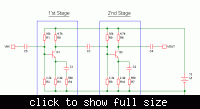samy555
Full Member level 4
Hi
If there are two BJT small signal amplifiers (common Emitter) cascade connected using a suitable decoupling cap
The first preamp has an o/p imeadance Zo, and the second has an i/p impedance Zin
Now we have Zo and Zin and a cap betwwen them
My question is: Is the connection series or parallel? That, is the o/p voltage divided or the o/p current?
If there are two BJT small signal amplifiers (common Emitter) cascade connected using a suitable decoupling cap
The first preamp has an o/p imeadance Zo, and the second has an i/p impedance Zin
Now we have Zo and Zin and a cap betwwen them
My question is: Is the connection series or parallel? That, is the o/p voltage divided or the o/p current?

